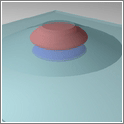Nanotechnology: ACT x 10e-9

Nanotechnology could pave the way to more compact, integrated systems and incorporate high-end sensors in spacecraft. These webpages are intended to show the nanotechnology community how their scientific work might have repercussions and applications in the space domain.
The science of the very small material components, like atoms and molecules, and the science of materials in their bulk configuration has been object of study since the development of the quantum mechanics. Today the fundamentals of the models developed to describe those systems are well establish. In between these two limits, i.e. the atoms and the bulk materials, it is possible to find aggregates of matter that exhibits new phenomena. These new phenomena result from the interaction of a finite number of atoms. The study of such "intermediate" systems is broadly known as nanoscience and the technologies which exploit these special properties as nanotechnologies. For those who are not familiar with this concept we have written a brief review trying to answer what nanotechnology is.
This field can be considered at present in the ACT as an emerging one, therefore the research lines are quiet broad. In the following lines we show a short description of them, in which the ongoing and future projects can be classified.
Science at the nanoscale
The nanotechnology can offer great advantages and solution to many engineering problems in space science. However to ensure that the envisaged technologies are feasible and reliable, the scientific background behind them should be well establish. The ACT is also focused on fundamental aspects of the nanoscience, which can contribute to the development of new devices. Thanks to the tight relation with the academic environment (Universities, Research Institutions, etc.) through the Ariadna program, different proposals are under study.
Research on nanodevices
The progress made in nanotechnology opens new possibilities for designing devices able to work beyond the technical limits of the microtechnology.
Systems integration
Nanotechnology in conjunction with the available microelectronic techniques offers new possibilities of system integration. Clear examples of this concept can be the integrated optics and integrated fluidics. Our aim in this field is make a review of the different systems in which a spacecraft can be divided and propose different alternatives to reduce its size and weight. Nanosatelites and picosatellites are therefore more feasible.
Transfer of techniques
The success in developing technologies working at the nanoscale regime is possible by a previous development of suitable theoretical models and experimental techniques. However this techniques can be also generalised in a way that can inspire solution of problems at a different scale.
Nanotechnology outside of the ACT
In order to get some guidance about the actual interests of ESA in Nanotechnology we suggest to read the open and intended Invitation To Tender (ITT). These pages contain a list of all the projects that the different directorates of ESA offer to Industry and Universities. The inspection of the list can provide quite an accurate picture of the technological trends inside ESA.